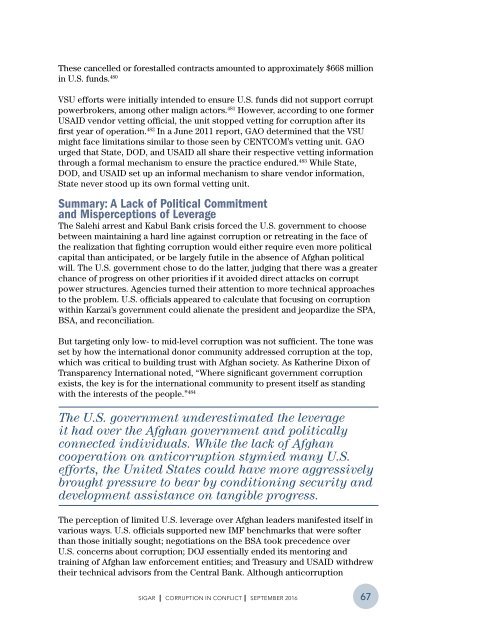CORRUPTION IN CONFLICT
5IlaWjQej
5IlaWjQej
Create successful ePaper yourself
Turn your PDF publications into a flip-book with our unique Google optimized e-Paper software.
These cancelled or forestalled contracts amounted to approximately $668 million<br />
in U.S. funds. 480<br />
VSU efforts were initially intended to ensure U.S. funds did not support corrupt<br />
powerbrokers, among other malign actors. 481 However, according to one former<br />
USAID vendor vetting official, the unit stopped vetting for corruption after its<br />
first year of operation. 482 In a June 2011 report, GAO determined that the VSU<br />
might face limitations similar to those seen by CENTCOM’s vetting unit. GAO<br />
urged that State, DOD, and USAID all share their respective vetting information<br />
through a formal mechanism to ensure the practice endured. 483 While State,<br />
DOD, and USAID set up an informal mechanism to share vendor information,<br />
State never stood up its own formal vetting unit.<br />
Summary: A Lack of Political Commitment<br />
and Misperceptions of Leverage<br />
The Salehi arrest and Kabul Bank crisis forced the U.S. government to choose<br />
between maintaining a hard line against corruption or retreating in the face of<br />
the realization that fighting corruption would either require even more political<br />
capital than anticipated, or be largely futile in the absence of Afghan political<br />
will. The U.S. government chose to do the latter, judging that there was a greater<br />
chance of progress on other priorities if it avoided direct attacks on corrupt<br />
power structures. Agencies turned their attention to more technical approaches<br />
to the problem. U.S. officials appeared to calculate that focusing on corruption<br />
within Karzai’s government could alienate the president and jeopardize the SPA,<br />
BSA, and reconciliation.<br />
But targeting only low- to mid-level corruption was not sufficient. The tone was<br />
set by how the international donor community addressed corruption at the top,<br />
which was critical to building trust with Afghan society. As Katherine Dixon of<br />
Transparency International noted, “Where significant government corruption<br />
exists, the key is for the international community to present itself as standing<br />
with the interests of the people.” 484<br />
The U.S. government underestimated the leverage<br />
it had over the Afghan government and politically<br />
connected individuals. While the lack of Afghan<br />
cooperation on anticorruption stymied many U.S.<br />
efforts, the United States could have more aggressively<br />
brought pressure to bear by conditioning security and<br />
development assistance on tangible progress.<br />
The perception of limited U.S. leverage over Afghan leaders manifested itself in<br />
various ways. U.S. officials supported new IMF benchmarks that were softer<br />
than those initially sought; negotiations on the BSA took precedence over<br />
U.S. concerns about corruption; DOJ essentially ended its mentoring and<br />
training of Afghan law enforcement entities; and Treasury and USAID withdrew<br />
their technical advisors from the Central Bank. Although anticorruption<br />
SIGAR I <strong>CORRUPTION</strong> <strong>IN</strong> <strong>CONFLICT</strong> I SEPTEMBER 2016<br />
67


